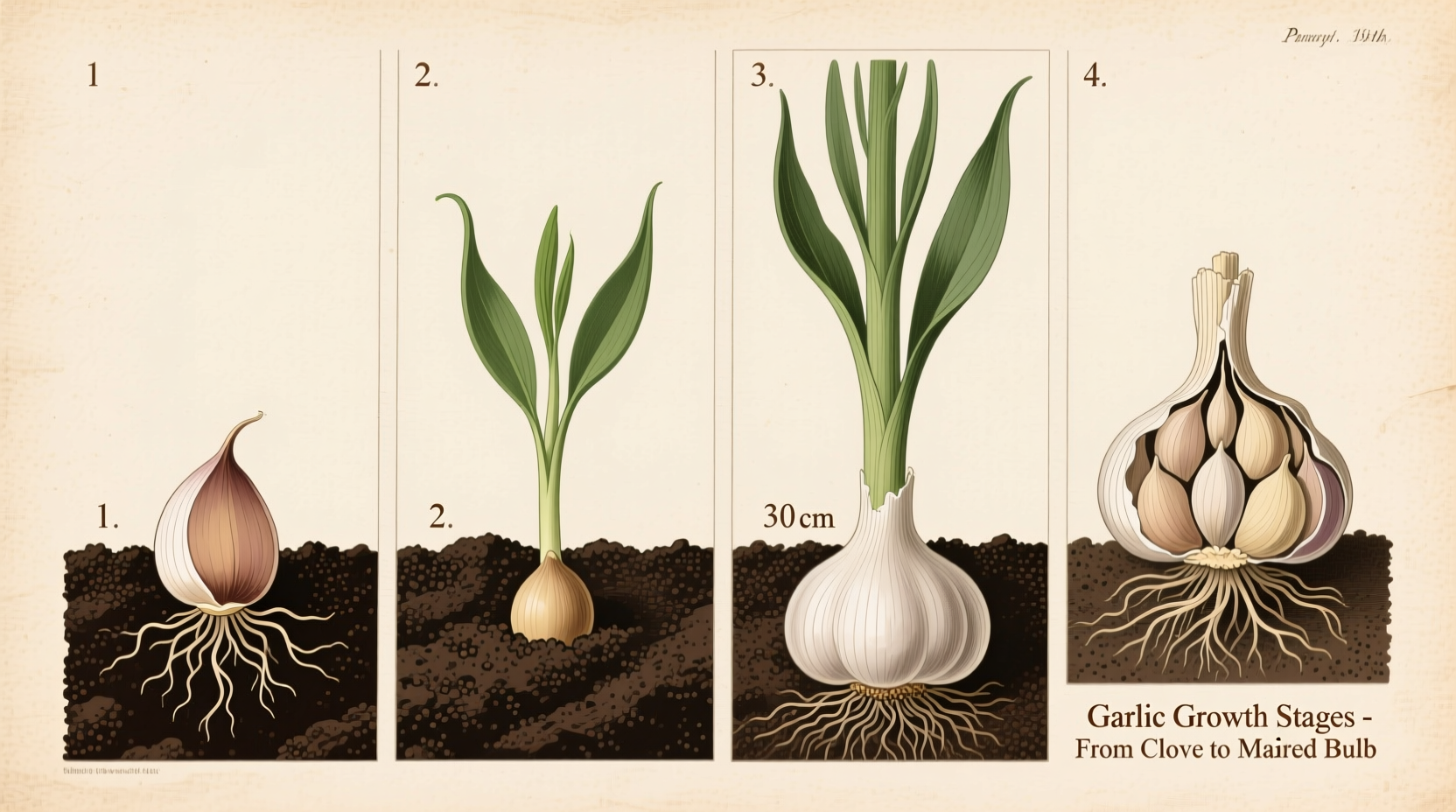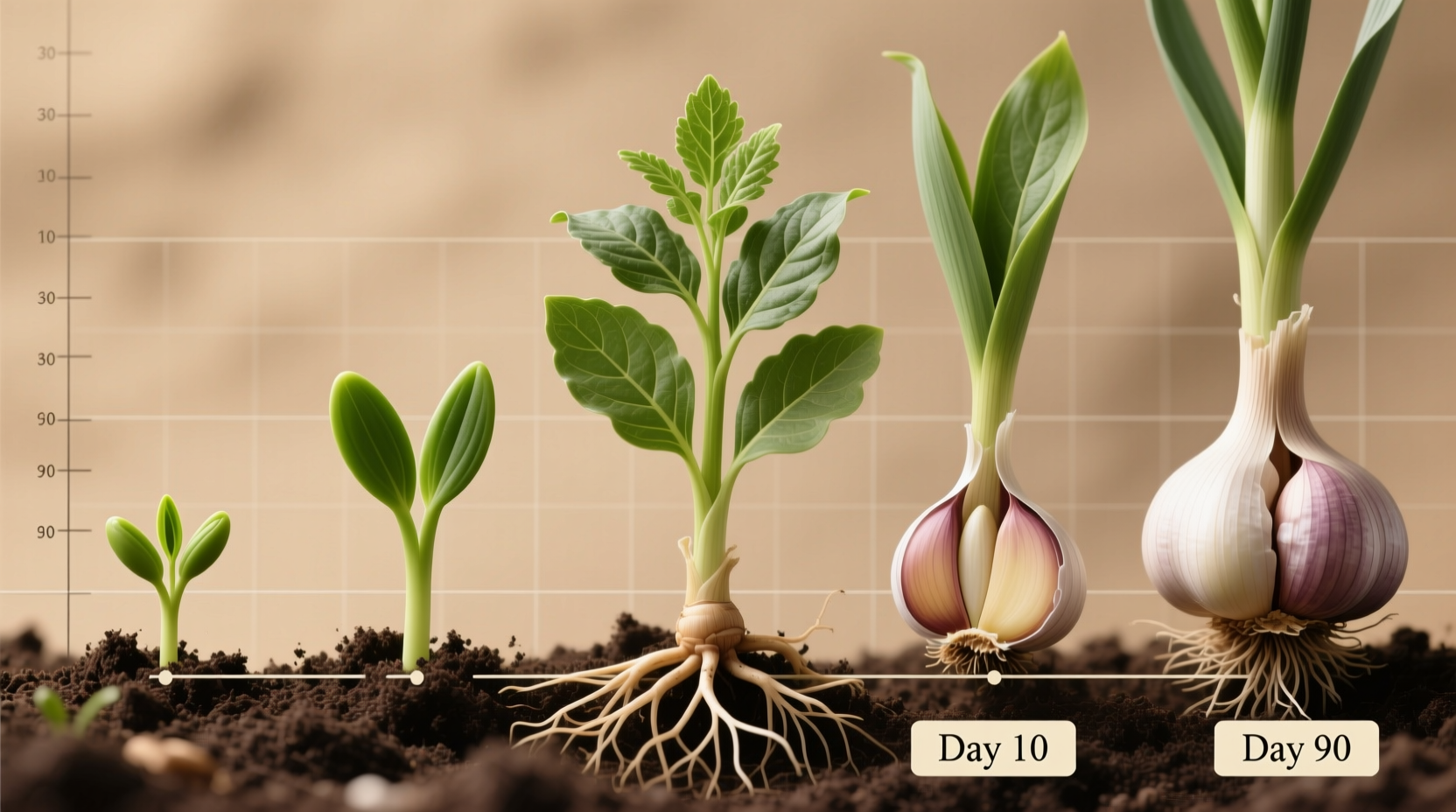Whether you're planning your first garden or expanding your homegrown spice collection, understanding garlic's growth timeline is essential for successful cultivation. This comprehensive guide breaks down exactly what to expect at each stage, helping you harvest robust, flavorful bulbs at peak maturity.
Garlic Growth Timeline: What to Expect Month by Month
Garlic follows a distinct seasonal pattern that aligns with natural temperature cycles. Unlike many vegetables, garlic is typically planted in fall and harvested the following summer, creating a growth cycle that spans multiple seasons.

| Month After Planting | Growth Stage | Visible Development | Care Requirements |
|---|---|---|---|
| 0 (Fall) | Planting | Cloves planted 2-4 inches deep | Soil preparation, mulching |
| 1-2 | Root Development | Roots establish, minimal top growth | Maintain moist soil, apply winter mulch |
| 3-4 (Winter) | Dormancy | Little visible growth | Protect from extreme cold |
| 5-6 (Early Spring) | Active Growth | Green shoots emerge, rapid leaf growth | Fertilize, maintain consistent moisture |
| 7-8 (Late Spring) | Bulb Formation | Bulb begins swelling, scape production (hardneck) | Remove scapes, reduce watering |
| 8-9 (Summer) | Maturity & Harvest | Lower leaves yellow, bulb fully formed | Dry soil before harvest, careful digging |
Factors That Determine Your Garlic's Growth Duration
The exact timeline for growing garlic isn't set in stone—it varies based on several key factors that every gardener should understand before planting.
Garlic Variety: Hardneck vs. Softneck
Choosing between hardneck and softneck varieties significantly impacts your growing timeline:
- Hardneck garlic (Allium sativum var. ophioscorodon): Grows best in colder climates, matures faster (7-8 months), produces edible scapes, and typically has 4-12 larger cloves per bulb. Varieties like 'Music' and 'German Extra Hardy' are popular choices for northern gardens.
- Softneck garlic (Allium sativum var. sativum): Better for warmer climates, takes longer to mature (8-9 months), stores longer, and has more numerous smaller cloves. 'Silverskin' and 'Artichoke' types like 'California Early' are common softneck varieties.
According to research from the USDA Agricultural Research Service, hardneck varieties generally require more chilling hours (4-8 weeks below 40°F/4°C) to initiate proper bulb formation, which explains their shorter overall growth period in appropriate climates.
Planting Time: Fall vs. Spring Planting
The timing of your planting dramatically affects growth duration and final yield:
- Fall planting (recommended in most climates): Plant 4-6 weeks before first frost. Garlic establishes roots before winter dormancy, then resumes vigorous growth in spring. This method typically yields larger bulbs and follows the standard 7-9 month timeline.
- Spring planting: Results in smaller bulbs as plants miss the crucial winter chilling period. Spring-planted garlic usually matures in 4-5 months but produces significantly smaller harvests.
University extension studies from Cornell Cooperative Extension show that fall-planted garlic typically produces bulbs 25-50% larger than spring-planted garlic due to the extended root development period.
Optimizing Your Garlic Growing Conditions
While the basic timeline remains consistent, you can influence growth speed and quality through proper cultivation techniques.
Soil Preparation for Faster Bulb Development
Garlic thrives in well-drained, loose soil rich in organic matter. Prepare your planting bed 2-3 weeks before planting by:
- Amending with 3-4 inches of compost or well-rotted manure
- Mixing in balanced organic fertilizer (5-10-10)
- Ensuring soil pH between 6.0-7.5
- Creating raised beds in areas with heavy rainfall
Proper soil preparation can accelerate root development by 10-15%, potentially reducing overall growth time slightly while significantly improving bulb quality.
Water Management Throughout the Growth Cycle
Watering practices directly impact growth speed and bulb development:
- Root establishment phase (first 4-6 weeks): Keep soil consistently moist but not soggy
- Active growth phase (spring): Provide 1 inch of water weekly
- Bulb formation phase (late spring): Maintain consistent moisture
- Maturation phase (3-4 weeks before harvest): Gradually reduce watering to prevent rot and encourage proper curing
Research from the University of California Cooperative Extension demonstrates that consistent moisture during bulb formation increases final bulb size by 20-30% compared to irregular watering schedules.
Recognizing When Garlic Is Ready to Harvest
Timing your harvest correctly is crucial—harvest too early and bulbs won't be fully developed; harvest too late and bulbs may split open, reducing storage life.
Watch for these key maturity indicators:
- Leaf count: When 40% of leaves have turned brown (typically 5-6 green leaves remaining)
- Bulb wrappers: Dry, papery covering visible when gently brushing soil away
- Cloves: Firm and well-defined when gently squeezing the bulb area
- Calendar timing: Approximately 8-9 months after fall planting
For hardneck varieties, the scape (flower stalk) typically straightens about 3-4 weeks before harvest time, providing another visual cue. The USDA National Institute of Food and Agriculture notes that harvesting based on leaf count rather than calendar date results in 25% higher quality bulbs with better storage characteristics.
Troubleshooting Common Growth Delays
Sometimes garlic takes longer than expected to mature. Understanding these common issues can help you stay on track:
Why Your Garlic Might Be Taking Longer to Grow
- Insufficient chilling hours: Garlic requires 4-8 weeks below 40°F (4°C) to initiate bulb formation. In mild winter climates, this can delay development.
- Poor soil conditions: Heavy clay soils or nutrient deficiencies slow root development and bulb formation.
- Planting depth issues: Cloves planted too shallow may experience temperature fluctuations; too deep delays emergence.
- Overcrowding: Plants spaced less than 4-6 inches apart compete for resources, reducing bulb size and potentially extending growth time.
According to the Royal Horticultural Society's gardening trials, garlic planted at the optimal 2-inch depth in well-prepared soil reaches maturity approximately 10-14 days faster than garlic planted in unamended soil at incorrect depths.
Post-Harvest Processing: The Final Stage of Your Garlic Journey
The growth timeline doesn't end at harvest—proper curing and storage complete the process:
- Curing period: 2-3 weeks in a warm, dry, well-ventilated space
- Storage readiness: When necks are fully dry and roots trimmed
- Storage duration: Hardneck: 4-6 months; Softneck: 8-12 months in cool, dry conditions
Skipping proper curing reduces storage life by up to 75%, effectively wasting your entire growing effort. The Agricultural Marketing Resource Center emphasizes that curing at 75-80°F (24-27°C) with good air circulation produces garlic with optimal flavor development and storage characteristics.
Maximizing Your Garlic Growing Success
For the best results with your garlic crop, follow these professional tips:
- Rotate planting locations annually to prevent disease buildup
- Use certified disease-free seed garlic (never grocery store bulbs)
- Apply nitrogen fertilizer when green shoots reach 4-6 inches tall
- Remove flower stalks (scapes) from hardneck varieties to direct energy to bulb development
- Test soil pH annually and amend as needed
By understanding the complete growth timeline and optimizing conditions at each stage, you'll consistently harvest robust, flavorful garlic that enhances your culinary creations throughout the year. Remember that patience is key—garlic's extended growth period results in complex flavor development that makes the wait worthwhile.











 浙公网安备
33010002000092号
浙公网安备
33010002000092号 浙B2-20120091-4
浙B2-20120091-4